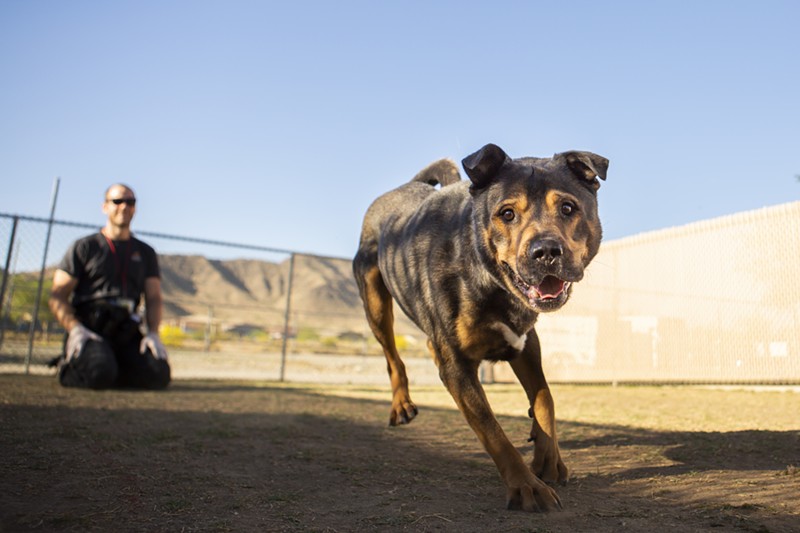It’s a situation that’s difficult under the best weather conditions but downright untenable when temperatures soar above 100 degrees for extended periods of time.
“Summer, especially July, historically is the busiest time of year for animal shelters nationwide, not just here in Maricopa County,” said MCACC Communications Director Kimberly Powell.
MCACC has two shelters: the West Valley Animal Care Center on 27th Avenue in Phoenix and the East Valley Animal Care Center on Rio Salado Parkway in Mesa. Between both locations, there are 755 kennels, which includes space for animals that are in bite quarantine and a sick isolation ward. According to Powell, the optimum capacity for adoptable dogs is 640. As of late July, MCACC had more than 840 dogs waiting for forever homes.
When this happens, the shelter must double up on kennel space.
Inside, the kennels are climate controlled. Outside, dogs are kept as comfortable as possible with swamp coolers, fans, a shade structure and misting systems. “We try to keep dogs on the outside that are going to be okay in the hot weather. We don’t put huskies or fluffy German shepherds out there. It’s not ideal by any means when it’s 110-plus outside. Those fans and misting systems can only do so much,” Powell said.

Stray and lost dogs and cats that are injured or suffering from heat distress are brought to Arizona Humane Society’s Sunnyslope campus.
Arizona Humane Society
‘Not used to this extreme heat’
July in Phoenix was the hottest month on record for any U.S. city, according to the Arizona State Climatologist and Arizona State Climate Office, helped by 30 days of temperatures at or above 110 degrees. And the National Weather Service predicts more above-normal temps throughout August. “All types of pets, especially domestic pets, are not used to this extreme heat we’re seeing, and they’re not really equipped to deal with it,” said Kelsey Dickerson, a spokesperson for the Arizona Humane Society. “This fiscal year alone, the Arizona Humane Society has received more than 1,300 calls for pets in heat distress.”
Like MCACC, AHS is at capacity. “We’ve been seeing capacity unlike any other year since pre-pandemic,” Dickerson said.
Stray and lost dogs and cats that are injured or suffering from heat distress are brought to AHS’s Sunnyslope campus, which includes the organization’s trauma hospital and specialized ICUs. Adoptable animals are housed at the Nina Mason Pulliam South Mountain Campus on Dobbins Road in Phoenix and PetSmart Scottsdale on Miller Road. Currently, AHS has about 600 pets in its shelter system and another 600 pets in foster homes.
Dickerson said that AHS staff members have been limiting outdoor activity for any animal in their care. “This heat is just so dangerous. We’ll bring them out twice a day — once in the morning and once at night, and we limit their activity when it’s this hot to 5 minutes maximum outside,” she explained.
But the department that is being taxed the most is AHS’ Field Dispatch Team, which consists of cruelty investigators and emergency animal medical technicians.
“They’re out there each and every day,” she said. “As you can imagine, not having water or shelter in the winter is not quite as life-threatening as being outside in 115 degrees with no water, no shelter. Those types of calls become much more urgent in summer.”
Dickerson noted that the team recently has been receiving 50 to 60 calls a day about animals in distress.
At the Arizona Animal Welfare League, located on North 40th Street in Phoenix, the heat has caused the shelter to cut back on its hours. “When it gets extremely hot, we keep our entry doors closed, but when we have adoptions, those doors are opening a lot more often. By limiting adoptions and closing our main shelter to the public, we’re able to keep the cooler air in and make sure that our animals are safe and comfortable,” said Kimberly Vermillion, director of communications for AAWL.
Still, Vermillion said that she has seen a decrease in adoptions.
“We usually do better in the summer because school is out, but even with a couple adoption events, we didn’t see the numbers that we were expecting because it’s too hot for people to come out.” On a typical day, the organization has about 200 animals in its shelter. Right now, in addition to its partner locations and in foster homes, it has more than 400 animals in its care.
To help the pets in its shelter keep cool, AAWL provides frozen treats, kiddie pools and sprinklers. “And once it’s 90 degrees, we limit outdoor time to quick potty breaks, and we don’t allow walks,” Vermillion said.
“We avoid bringing them on blacktop because that can get extremely hot. So that’s something for all pet owners to be mindful of during this time of year. Even at 9 a.m., if it’s 100 degrees outside, that blacktop is going to be extremely hot for your pup’s paws,” she explained.
On a hot summer day, with the sun beating down, black asphalt can surpass 170 degrees.

Kelsey Dickerson, a spokesperson for the Arizona Humane Society, said that AHS staff members have been limiting outdoor activity for any animal in their care.
Arizona Humane Society
Keeping pets safe during the heat wave
“We’re seeing a lot of dogs coming in dehydrated and lethargic after wandering around in the heat. Even if it’s just for an hour, it’s so hot outside that it can be dangerous,” Powell said.To help pet owners keep their animals cool, AHS has a downloadable document that provides information about recognizing and treating heatstroke in pets as well as tips for keeping animals safe.
First and foremost, unless they absolutely must go outside, pets should remain indoors, especially during the strong midday heat. When walking dogs, it’s important to realize that their feet can and will burn. “A good indicator is to go outside and stick your hand on the sidewalk. If you can't hold it there for 10 seconds without it burning, don't take your dog on a walk,” Powell said.
Animals that are in heat distress will exhibit such signs as excessive panting and drooling, an elevated heart rate or body temperature, glazed eyes and bright red gums or ears. Heatstroke presents with vomiting or diarrhea, seizures and weakness, or even unconsciousness.
If you happen to come across an unaccompanied dog or cat that appears to be in heat distress, Powell recommends capturing it — if you can do so safely — and bringing it indoors or into some shade before calling MCACC and filing a found pet report. If you cannot capture the animal, call MCACC or your local police. If the animal is a neglected pet — perhaps your neighbor leaves his dog outside all day — contact AHS.











